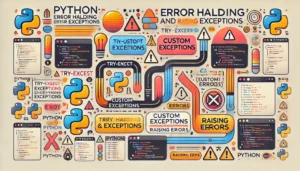Handling errors effectively in Python is crucial for building reliable, robust, and user-friendly applications. Python’s error handling mechanism, using try, except, else, and finally blocks, empowers you to gracefully manage exceptions, provide clear error messages, and maintain the stability of your software.
This series of exercises introduces you to handling common exceptions like ZeroDivisionError, KeyError, and ValueError, along with more advanced concepts like custom exceptions, nested try-except structures, and the use of assertions. By mastering error handling, you’ll improve your debugging skills, enhance code reliability, and deliver better user experiences through clearly communicated outcomes when unexpected situations occur.
🚀 Jump Right to Exercise Tasks: Python Exercises – Error Handling and Exceptions
Understanding try-except Blocks
The try-except block allows you to test blocks of code for errors and handle exceptions that arise. It’s essential when operations might fail unpredictably, such as user inputs, file operations, or network requests.
Practical Example
Imagine dividing two numbers, where dividing by zero causes a crash. Here’s how to handle it:
try:
result = 10 / 0
except ZeroDivisionError:
print('Error: division by zero.')Example Output:
Error: division by zero.Key Takeaways:
- Use try-except to handle predictable errors.
- Provides clear feedback when something goes wrong.
- Prevents your program from crashing unexpectedly.
Raising and Handling Custom Exceptions
Python allows you to define custom exceptions to handle specific error cases clearly and distinctly. Custom exceptions improve readability and debugging, as you can precisely indicate what went wrong.
Practical Example
Let’s enforce a rule that numbers must be positive:
class NegativeNumberError(Exception):
pass
def check_positive(number):
if number < 0:
raise NegativeNumberError("Number must be positive")
try:
check_positive(-5)
except NegativeNumberError as e:
print(e)Example Output:
Number must be positiveKey Takeaways:
- Create meaningful custom exceptions.
- Enhance clarity and control over error handling.
- Precisely identify specific error scenarios.
Using Finally to Ensure Cleanup
The finally block executes whether an exception occurs or not, ideal for cleanup tasks like closing files or releasing resources. This ensures your program remains efficient and resource-friendly.
Practical Example
Attempting to open a file that might not exist:
try:
file = open('nofile.txt', 'r')
except FileNotFoundError:
print('File not found.')
finally:
print('Finally block executed.')Example Output:
File not found.
Finally block executed.Key Takeaways:
- finally always runs regardless of exceptions.
- Use finally for guaranteed resource cleanup.
- Enhances reliability and stability.
What You’ll Gain from Completing This Exercise
Completing these exercises equips you with robust error handling strategies in Python, significantly boosting your debugging abilities and overall code quality. You'll become proficient at managing exceptions, writing clearer code, and providing better user experiences.
How to Complete the Exercise Tasks
Use the interactive Python editor provided below each task:
- Write your Python code: Type your solution into the editor.
- Run your script: Click "Run" to execute your code and view results.
- Check your solution: Click "Check Answer" to verify correctness.
- Reset the editor: Click "Reset" to clear and start fresh.
Earn XP, Unlock Rewards, and Track Progress!
If logged in, each completed task earns XP, unlocking new levels, exclusive Avatars, Frames, and improving your leaderboard status. Progress saves automatically for continuous learning and motivation.


